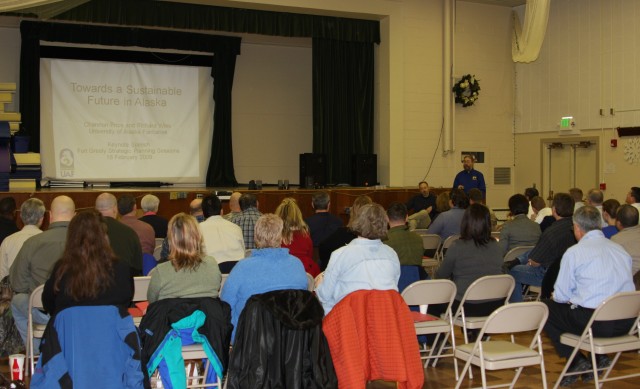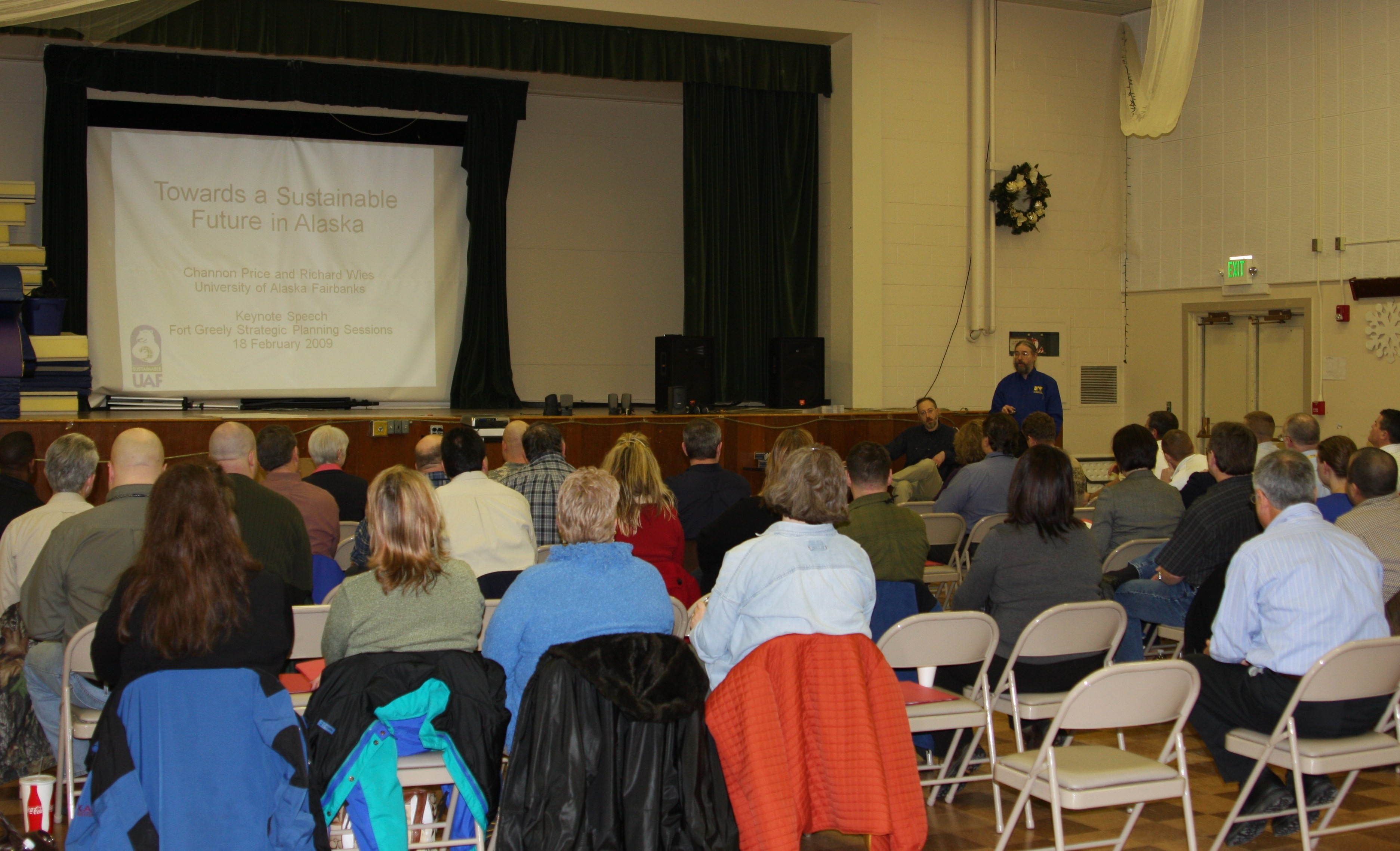Fort Greely became the first Alaska Installation to lead the Army's nationwide Sustainability Initiative with its Strategic Sustainability Goal Setting Conference conducted here Feb. 18-20. The purpose of the conference was to incorporate sustainable practices into Fort Greely's vision for the future.
According to the U.S. Army Sustainability website, the Army Strategy for the Environment: Sustain the Mission - Secure the Future establishes a long-range vision that enables the Army to meet its mission today and into the future. Sustainability is the foundation for this Strategy and a paradigm that focuses our thinking to address both present and future needs while strengthening community partnerships that improve our ability to organize, equip, train, and deploy our Soldiers as part of the joint force.
The Fort Greely conference opened with remarks from Lt. Col. Chris Chronis, garrison commander, followed by keynote speakers, Doctors C.P. Price and Richard Wies, from University of Alaska Fairbanks. The speakers shared their experience in sustainability, providing examples of the nation's current energy consumption and how sustainable practices are transforming an energy crisis into an opportunity.
The conference encompassed the garrison, tenant organizations, participants from Fort Wainwright, Delta Junction Mayor Mary Leith-Dowling and various members of the Delta Junction community.
Over the course of two and a half days, garrison directors and appointed representatives broke into Quality of Life, Infrastructure, Workforce, and Logistics groups to develop strategic goals for the garrison's 25-year vision.
Facilitators from all regions of the United States traveled to Fort Greely to help guide conference attendees and launch Fort Greely's 5- to 25-year strategic plan. They were: Michael La Duc, David Zuckerman, Melissa Iwamuro, Dr. S. Lynn Odom, Gwen DiPietro and Jayme Peterson.
The conference resulted in the following Fort Greely final strategic goals:
Infrastructure Goal 1: Our strategic planning will be the benchmark for integrated garrison planning and programming which meets the needs of current and future users. Goal 2: Arctic benchmark for modernized infrastructure and utilities that provide for current and future mission requirements to attain energy efficiency and self sufficiency while ensuring environmental stewardship. (Mentor local community for sustainable cold climate facilities, provide for sustainable logistics facilities and Go Green).
Quality of Life Goal 1: Sustainable housing meets community needs. Goal 2: Community Partnerships Forged. Goal 3: Communities Go "Green." Goal 5: New State of the Art Medical Facility Available. Goal 6: Cyber-space technology enhances work and education. Goal 7: Strategic Plan lays foundation for the future. Goal 8: "TEAM" Greely Launched.
Logistics Goal 1: A Budgeting and Programming system that fully supports Fort Greely's requirements. Goal 2: Efficient, secure, environmentally-friendly Logistics facilities to support the Fort Greely mission. Goal 3: Effective, cost-efficient Logistics processes/procedures to support the Fort Greely mission that exceed Installation Management Command and Army standards. Goal 4: A secure, efficient and environmentally friendly transportation system to support the Fort Greely mission. Goal 5: The capability to store and deliver fuel to support the Fort Greely mission under all conditions.
Workforce Goal 1: Achieve and maintain a minimum 80 percent staffing objectives. Goal 2: Offer professional development and experience opportunities which can lead to career enhancement in accordance with individual development plans. Goal 3: To attract potential employees to Fort Greely and provide a positive perception of Fort Greely's physical and work environments through proactive recruitment and marketing programs. Goal 4: To obtain exceptions when existing policies restrict hiring qualified personnel for mission requirements. Goal 5: Maintain employees for a minimum of 36 months by providing OCONUS-type benefits/incentives (packages, such as airfare, home leave, R&R, pack). Goal 6: Enhance career counseling methods and cross-leveling of positions, educational and training development programs, mentorship programs, IDPs, developmental assignments within garrison, effective transfer of institutional knowledge.
Guest speaker Jack Hebert, member of the International Sustainability community and pioneer of Cold Climate Sustainable Housing Research Center located on the University of Alaska Fairbank's campus, wrapped up the conference.
As leadership in energy and environmental design principles become a priority for the Army's and Fort Greely's expansion, Hebert's presentation provided proven examples of cost-effective, sustainable practices that accommodate Alaska's unique climate challenges.
"I want to thank all who participated in making Fort Greely's Sustainability Conference an outstanding success," said Chronis. "I'm proud of Fort Greely and Delta Junction for charging ahead with this initiative. It's very important to have long-term strategies to ensure Fort Greely and Delta Junction thrive and that we meet the Army missions of the future."
The next workshop "Fort Greely's Action Planning" will be held May 18-22. In this workshop the four groups will map an action plan how to achieve our strategic goals.


Social Sharing